What Size Case Fan Do I Need
In this article, we're going to teach you all y'all need to know to buy the best case fans for your needs.
After going through all relevant case fan specs and what they actually hateful, we'll also requite you lot a selection of our top four picks. Along the way, we'll as well discuss things like the departure between PWM and non-PWM fans, when you need dedicated fan controllers, and more!
Let'south dive in.
Best Case Fans
Here's an overview for those of you simply looking for some quick recommendations. Nosotros consider these the best Case Fans y'all tin can become for your PC:
| Note | Best Case Fan | Link |
|---|---|---|
| Value Pick | Noctua NF-P12 redux | Info / Purchase |
| Placidity Pick | be tranquillity! Silent Wings 3 | Info / Buy |
| RGB Performance Pick | Deepcool RF120 RGB | Info / Buy |
| RGB Niche Pick | Thermaltake Riing Plus 20 RGB TT Premium | Info / Buy |
What Y'all Demand From Your Case Fans
Commencement, let's go over technical specifications and what they actually mean.
Common Sizes / Are 140 mm fans better than 120 mm?
The first thing you'll need to know before buying a case fan is what size you need. Larger fans tin can push button more air more quietly, merely not every case is going to accept room for a 200mm+ fan size. Some cases may not fifty-fifty have room for the standard 120mm fan size, but those are outliers for the standard ranges of Mini ITX to Extended ATX cases.
The "mm" measurement stands for millimeters and measures ane of the fan'due south four equal sides. (Not their radius or bore, as yous may be led to believe.)
This standard is followed by every case fan manufacturer in the manufacture, and it also leads to a mere "120 mm fan" being a lot larger than information technology actually sounds – usually slightly larger than the palm of an adult male.
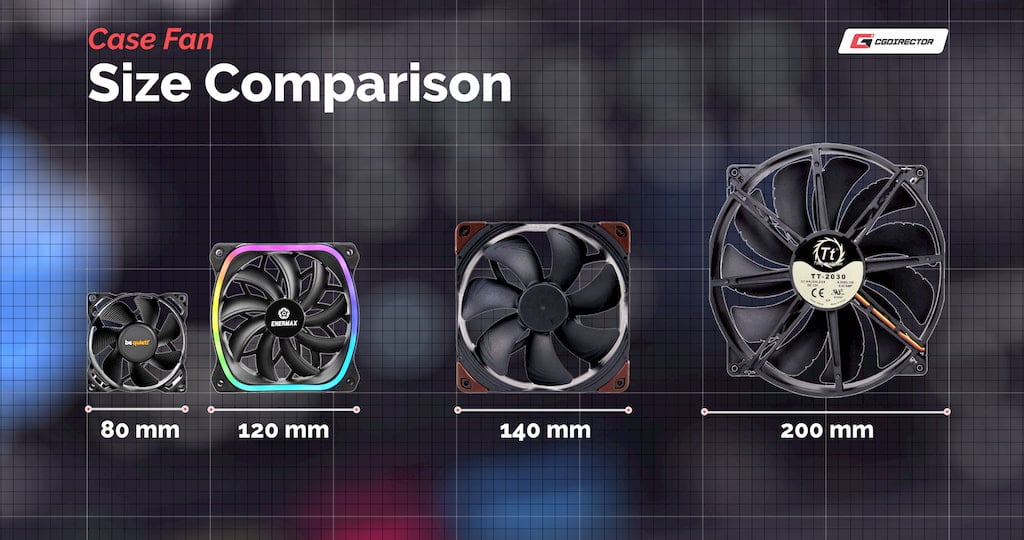
120 mm Fan Size
The smallest of the "Big Three" measurements, and the most ubiquitous. 120 mm fans are by far the virtually commonly-used course gene for instance fans across all sizes and toll ranges, and are even seen in high-stop cooling solutions.
For instance: most All-In-1 liquid cooling solutions and big air coolers will come with one or more 120 mm fans included and pre-mounted to the heatsink or radiator, in order to ensure the best possible oestrus dissipation.
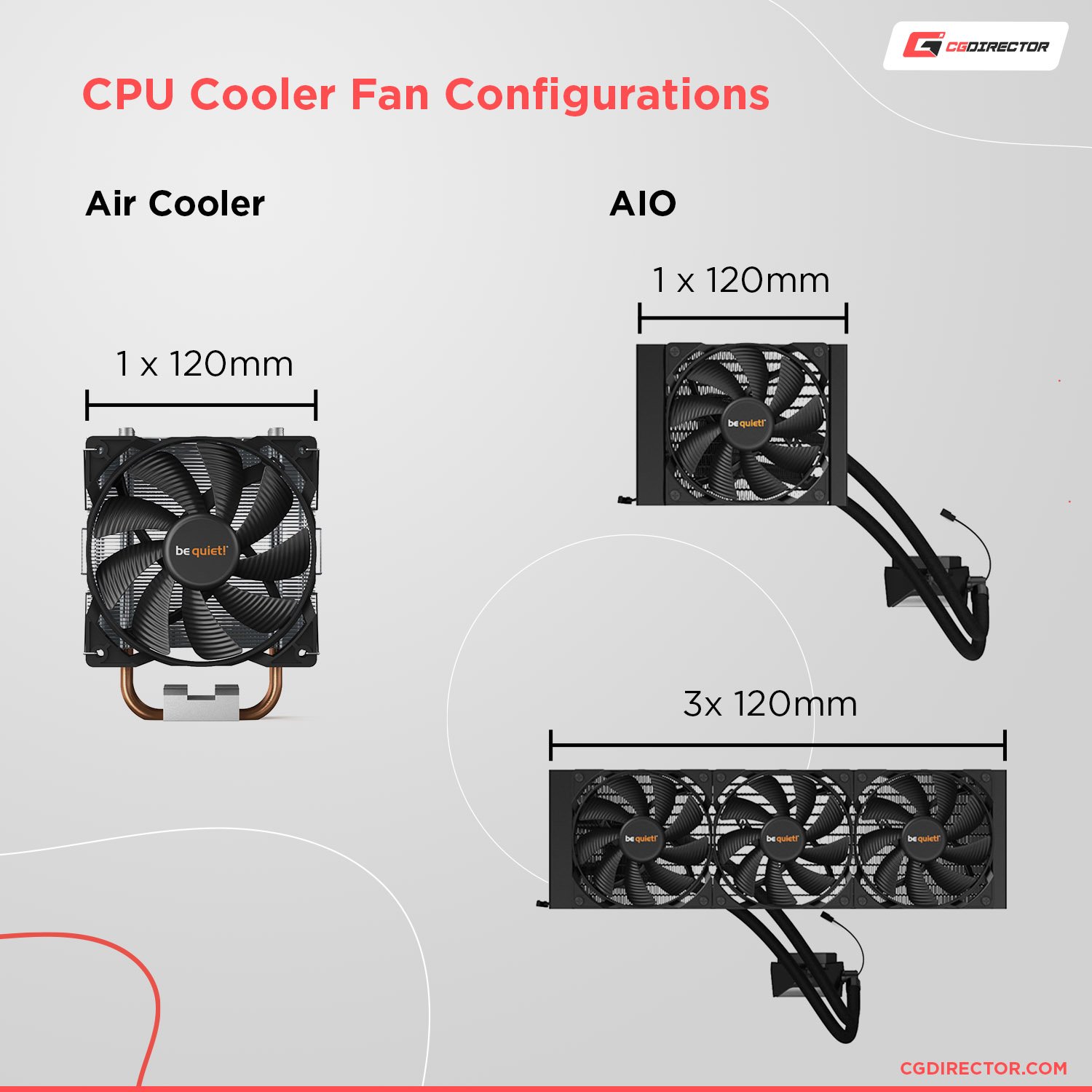
If y'all're building in or upgrading a Mini ITX/Micro ATX PC build, then 120 mm fans will usually be your all-time bet. If larger fan sizes are supported, though, we recommend opting for them instead. As said prior, larger fans can push more air more quietly.
Use Case:
- Pretty much any standard chassis from Mini ITX upwardly to Total Tower ATX
- The majority of AIO liquid cooling radiators
140 mm Fan Size
140 mm is the 2d near-used instance fan type, just isn't nigh equally ubiquitous as 120 mm. For 1, they're less likely to be compatible with the increasingly-shrinking PC cases populating the market place today.
Only even in cases that are compatible with both 140 and 120 mm fans, nearly users volition opt for 120 mm instead. While we can't ascertain the exact reason for this, we'd reckon it has something to do with lower prices and more familiarity.
Use Case:
- Larger PC cases, starting from some Micro ATX machines and moving upward to Mid-Tower ATX, Full Tower ATX, and Extended ATX Towers
- Supported liquid cooling radiators, custom loop or otherwise
200 mm Fan Size
200 mm is the third most-used example fan type, but is yet more than obscure than 140 mm fans. You'll most oft come across these as pre-installed in specialized Micro ATX/Mini ITX "cube" cases every bit intake fans, where sheer size helps compensate for otherwise-lost cooling potential.
If the case can't stack two 120 mm fans up front, chances are a single 200 mm fan will exist used instead.
Full ATX towers that offer 200 mm fan support are rare, only do be and are currently being sold. On the offchance that you're looking for one, MasterCase H500 may be what you're looking for.
Use Case:
- Either the smallest, nigh specialized ITX/MATX cube cases or the largest, near extravagant ATX Full Towers
- (Often at to the lowest degree one pre-installed where supported)
Uncommon Sizes
While the following fan sizes we're about to talk over hither are a chip…out of the scope of this commodity and our recommendations, we all the same feel similar they're worth mentioning.
Outside of the Big Iii, you may come across another case fan sizes out there – commonly smaller sizes, like 80 mm.
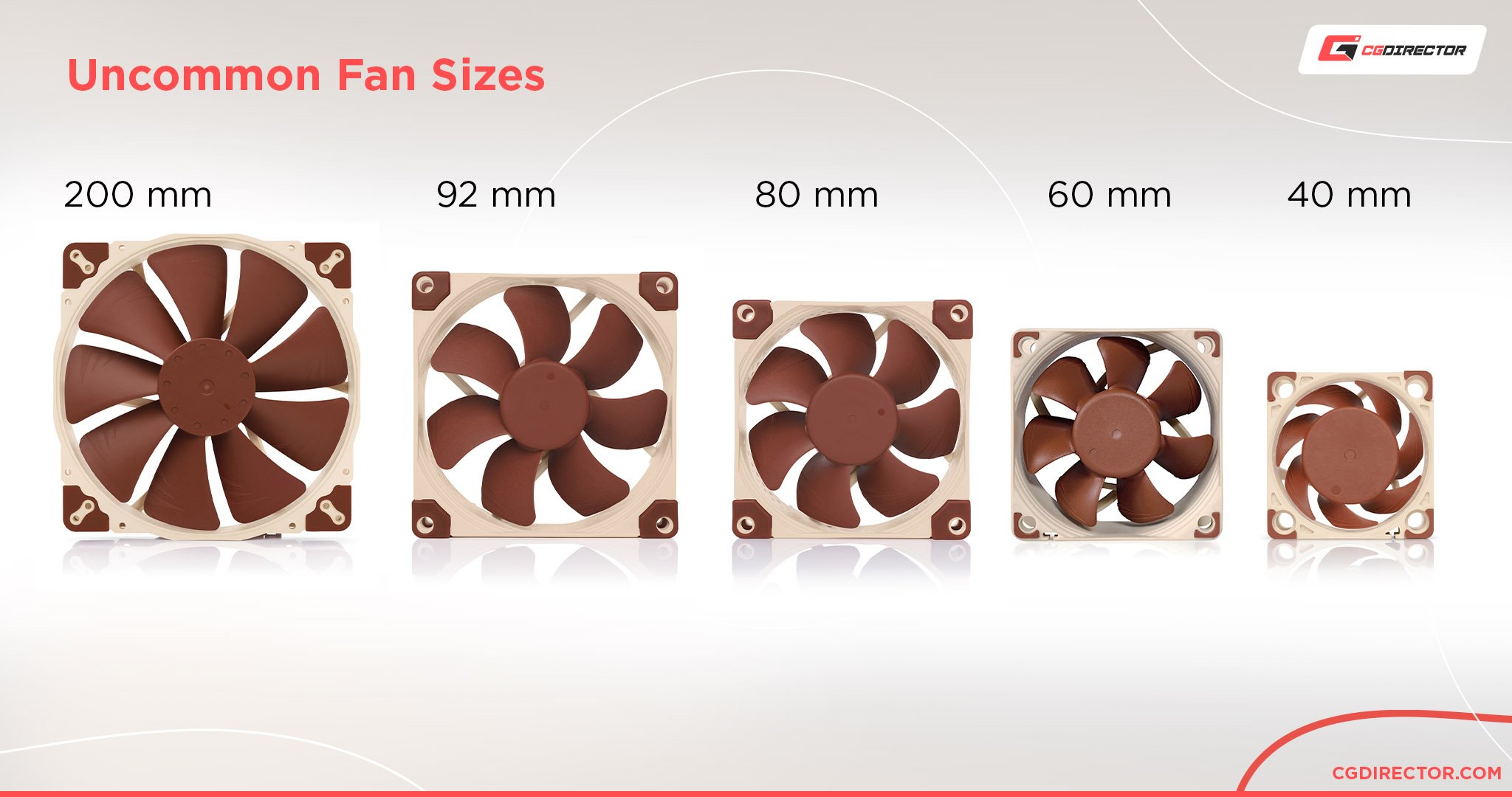
Where these come in handy are in particularly compact cases that are too small for fifty-fifty, say, a 120 mm exhaust fan. These are ordinarily seen in super-small Mini ITX, Mini STX, or Mini ATX cases, as well as some slimline prebuilt PCs.
At times, you may even come up beyond fan sizes larger than 200 mm, merely the use cases for these are few and far between.
Earlier ownership whatsoever case fans of whatever size, verify your case specs and compatible fans . Even if y'all're using a prebuilt PC with an obscure pre-installed fan with an equally-obscure size, chances are it'due south worth looking into a replacement that'due south capable of more.
Corsair, for instance, states clearly what type of Case Fans are supported in their respective PC-Case Manual:
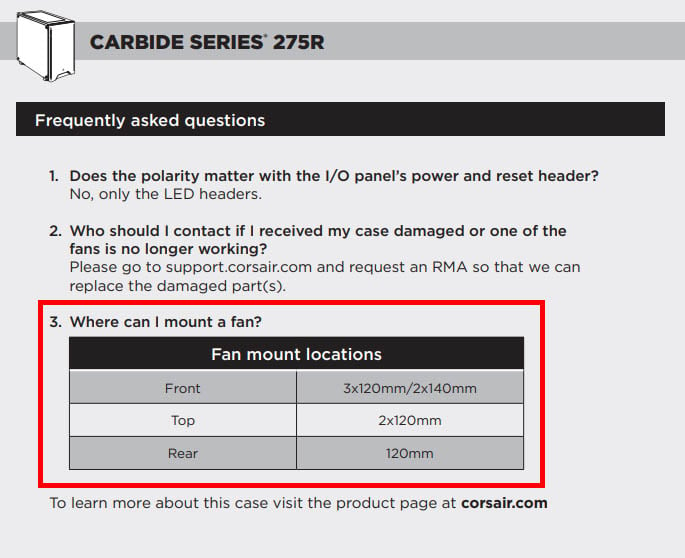
Image-Credit: Corsair Carbide 275R Manual
Don't wait to encounter extra features like RGB outside of the standard Large 3 case fan sizes, though.
What is PWM?
PWM stands for Pulse With Modulation, and in the context of example fans, refers to fans that are controlled via this method.
PWM is a method used to control a multitude of electronics, but in the context of PCs, information technology'south mainly for case fans and coolers.
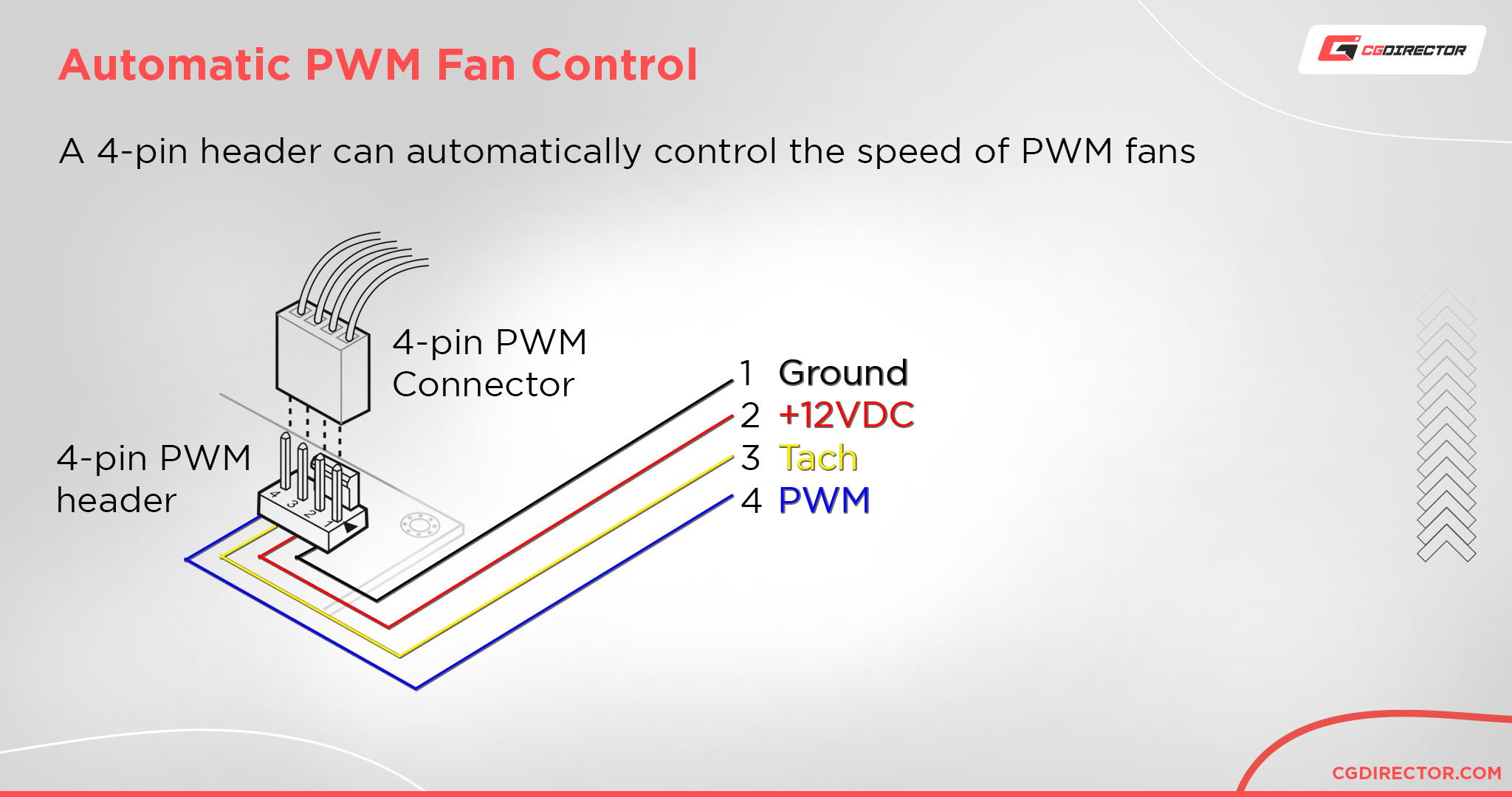
Interestingly, some (CPU) air coolers can be upgraded by merely replacing the fan that's already on information technology and add together a better one- or even an extra ane on the other side, to aid pull or push air through the heatsink.
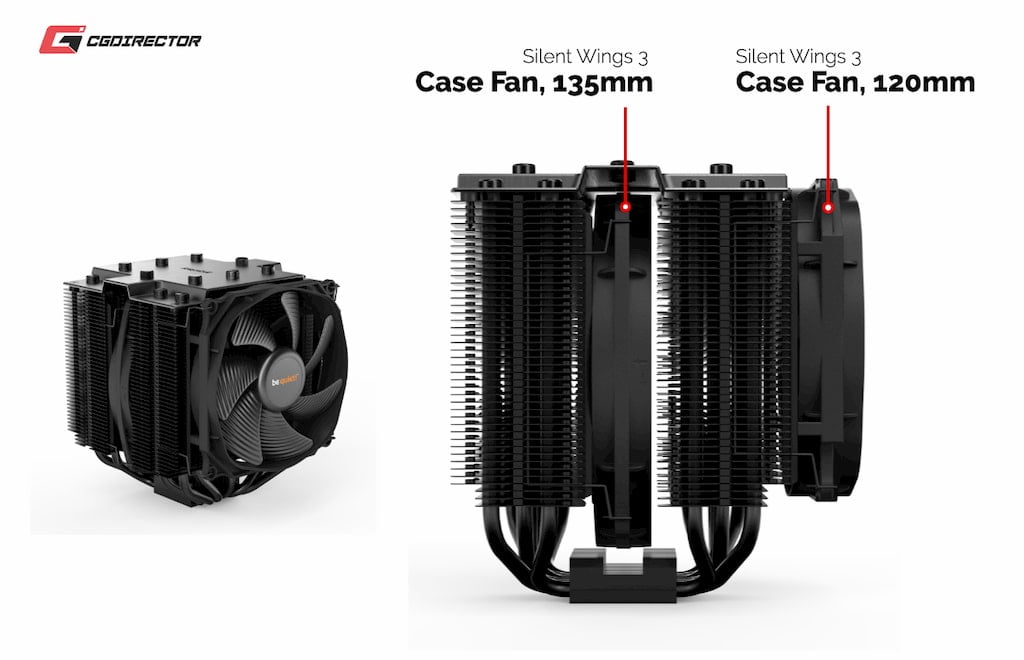
PWM Case Fans on a CPU Radiator (beQuiet Dark Rock Pro 4)
Depending on the size of the heatsink in question, this replacement/improver can oftentimes be a 120 or even 140 mm case fan.
Pulse Width Modulation itself can be a trivial complicated to explain, merely all you lot need to know is that information technology substantially functions past constantly turning the signal on and off, resulting in fine control of the ability going to the component in question.
Then, y'all're probably wondering- why bother with PWM fans ?
The answer is: control.
Specifically, PWM enables you to control things similar fan speeds, or RPM. Without PWM, your fans will simply run at full speed all the fourth dimension, which likewise means full power consumption and the loudest noise profile.
PWM fans may cost a little bit more than, but the actress money spent is well-nigh always worth it:
We do not recommend buying non-PWM case fans.
If you lot're wondering how RGB factors into this…we'll dive into that one a little chip later.
What is RPM?
RPM, or Rotations Per Minute, is a measure out of fan speed.
The higher the fan speed, the more air the fan will push or pull, only the louder the fan will be and the more ability information technology volition consume in your organization. The opposite is also truthful: if you tin can run your fan at lower speeds, you tin brand your organization a lot quieter…but it won't be cooled nearly also.
A large reason to buy PWM fans is and then that things similar your RPM can exist automatically controlled past your system, and then your fans run quietly when not much is going on, and only ramp-upward during intense tasks.
With the right automatic fan control curve, fans should only become loud during heavy gaming tasks or intense CPU Rendering & GPU rendering tasks.
The BIOS (Basic Input Output System) of your Motherboard usually controls the fan curves that can also exist manually adjusted as can be seen in this Gigabyte BIOS:
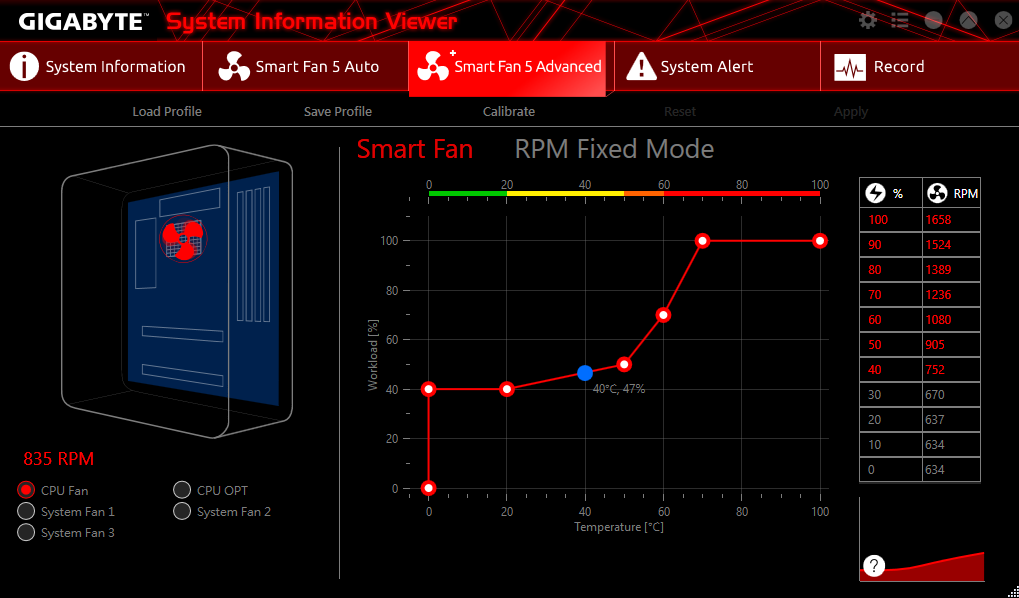
Image-Credit: Gigabyte
You tin can also choose to create your own fan control curves with the right applications. This is especially recommended if you lot desire to continue a quieter PC, and even more-and then if y'all happen to be using a liquid cooler.
What is CFM?
CFM stands for Cubic Feet per Minute, and is a measure of airflow into or out of the case.
The higher the CFM, the better the airflow– and therefore, the libation your temperatures. In order to reach maximum CFM, though, you'll need to either ramp-upwardly to max RPM/fan speed via fan control, or exist using a non-PWM fan that runs at total speed all the time.
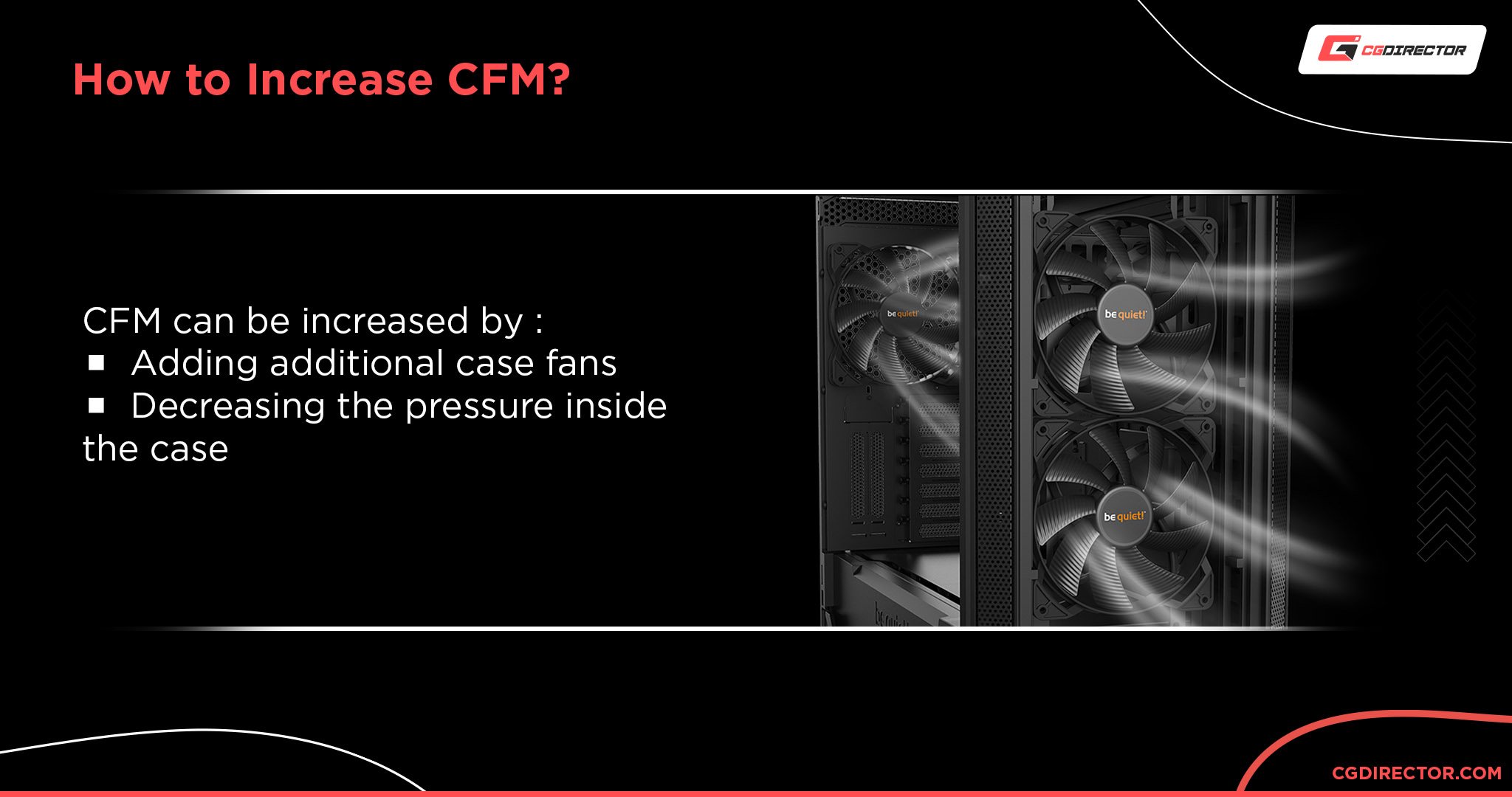
When shopping for instance fans, CFM is an important metric to wait out for.
Your average 120 mm case fan will offer anywhere from 40-fifty CFM, with particularly skillful ones offering l-60 CFM and higher. College CFM is technically possible at this size, simply would in turn crave ridiculously high RPM, ability consumption, and noise levels.
Static pressure and loftier airflow fans
At that place are actually two unlike kinds of PC instance fans: static pressure fans, and high airflow fans. There are also a number of fans that occupy a sort of hybrid position, offering both high airflow and at least decent static pressure, only those are a bit rarer.
If y'all're like most people, your instinct is probably to go directly for loftier airflow fans and forget the rest. After all, isn't the whole signal of a fan to ensure adept airflow?
Yes, but… static force per unit area is important as well . To understand why we'll need to explain the concept of static pressure level.
Essentially, static pressure isn't about the speed which air is existence pushed or even the amount. Instead, static pressure is about the force with which the air is being pushed. In many scenarios, high static pressure fans will provide much improve performance than loftier airflow fans despite much lower CFM.
This applies especially to things like heatsinks and radiators, but tin can also employ to many intake fan positions.
The growing popularity of solid-material front panels with side or bottom vents means that you lot'll actually want static pressure fans in a "pull" configuration here, since they will be able to pull in air with the most strength.
For exhaust fans , or intake fans not dealing with a solid-material front panel, a focus on high airflow/CFM is your best bet.
Is positive or negative airflow improve?
If you've heard a lot near positive or negative airflow- or more accurately, positive or negative force per unit area-and aren't sure which is amend, allow us clear it upwards real quick:
A positive pressure configuration is where more air is coming into the instance than is being pushed out. This is by and large recommended for most users, since (especially if you have proper filters) it minimizes excess dust getting into your PC and causing problems.
A negative force per unit area configuration is the opposite, where more air is being pushed out than is coming in. This can be skillful, but it essentially turns the inside of your PC into a vacuum, which will result in lots of extra dust getting into your PC.
For the best results, yous'll desire a slightly positive pressure configuration.
To make up one's mind the force per unit area of your configuration, just add up the CFM of your intake fans and compare that to the cumulative CFM of your exhaust fans. Equally long as the intake is pulling in slightly more than is being pushed out, you have yourself a positive pressure configuration!
Decibel (dB) measurements and noise
Every bit you lot may already know, decibels are a mensurate of sound. What y'all may not know is how loud decibels actually are, so we're going to provide y'all with a reference chart, based on data from NoiseHelp.com and a Yale report.
- 0 – 10 decibels is extremely quiet, and deadline inaudible. The sound of a pin dropping is estimated at roughly ten decibels.
- 10 – 20 decibels is quiet, becoming slightly audible at the high-end. The sound of rustling leaves is estimated at 20 decibels.
- 25 decibels is roughly the level of whispers.
- 35 to 40 decibels is the audio of the suburbs at night or a running river.
- At 55 to 65 decibels, you get noisy– the fridge kicking on in the middle of the dark, normal speaking volume, etc.
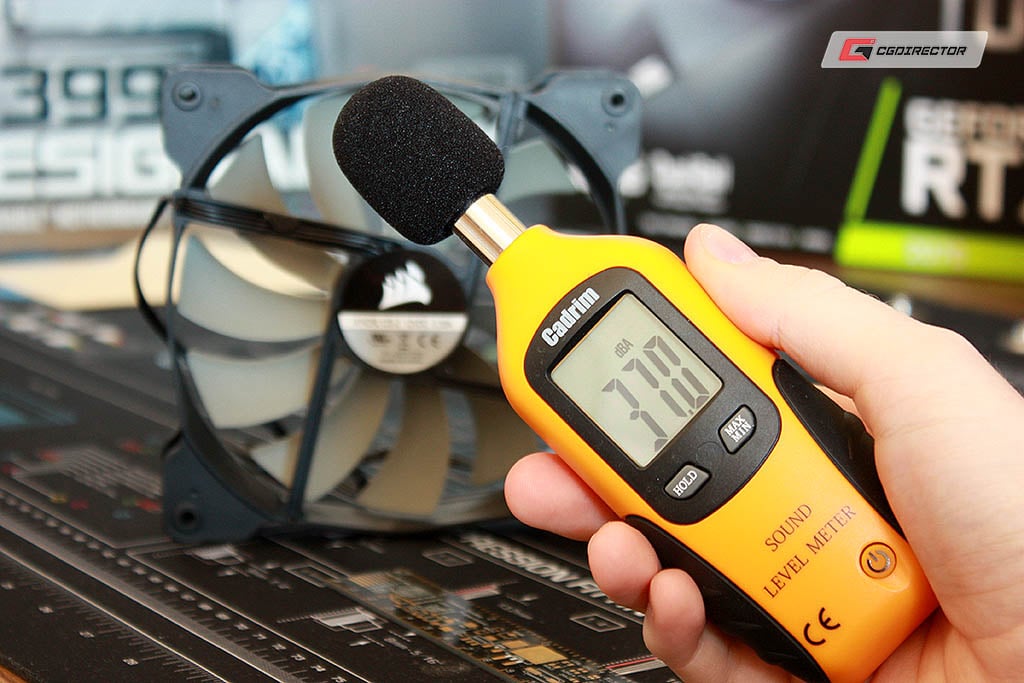
For case fans, "silent" fans are considered to be beneath 20 decibels, average fans are anywhere within the range of 20 to thirty decibels, and loud fans are anything louder than that. Most of the fans we've listed beneath fall into the quieter ranges, sans our final niche choice.
RGB and LED fans
RGB and LED fans are case fans with…well, LEDs for lighting.
RGB is a specific category of LED instance fans that let their colors to exist customized in various means, while LED fans come in a single colour.
An interesting point to note virtually RGB and LED fans is that very few seem to exist designed for loftier airflow, and are instead made for static pressure.
While nosotros aren't sure of the exact reason for this, we'd reckon it has something to practice with added weight/unlike manufacturing processes for fan blades that also need to carry and reflect low-cal.
RGB and LED fans practice not boost performance in any style, but chances are you lot knew that already 🙂
They too aren't a sign of higher build quality, either. Simply opt for RGB/LED fans if y'all want the aesthetic benefits, as that is their merely actual do good. If you aren't trying to prove off the inside of your PC, then actress lighting of any kind is purely superfluous.
In the case of RGB fans, you'll too demand to make sure that yous take an available RGB header on your motherboard:
RGB fans will come with two cables: one for the fan itself, and another for the RGB lights within. PWM by itself isn't enough for controlling RGB lighting effects, and you'll likewise need a compatible RGB connector on your motherboard.
If you don't take an RGB connector on your motherboard- or if you don't have enough for all of the RGB fans y'all desire to install- and so yous'll have to invest in a fan controller.
Fan controllers and multi-fan setups
If you need to employ a fan controller, chances are it has something to practise with multi-fan setup woes, especially if y'all're building with a more modern motherboard.
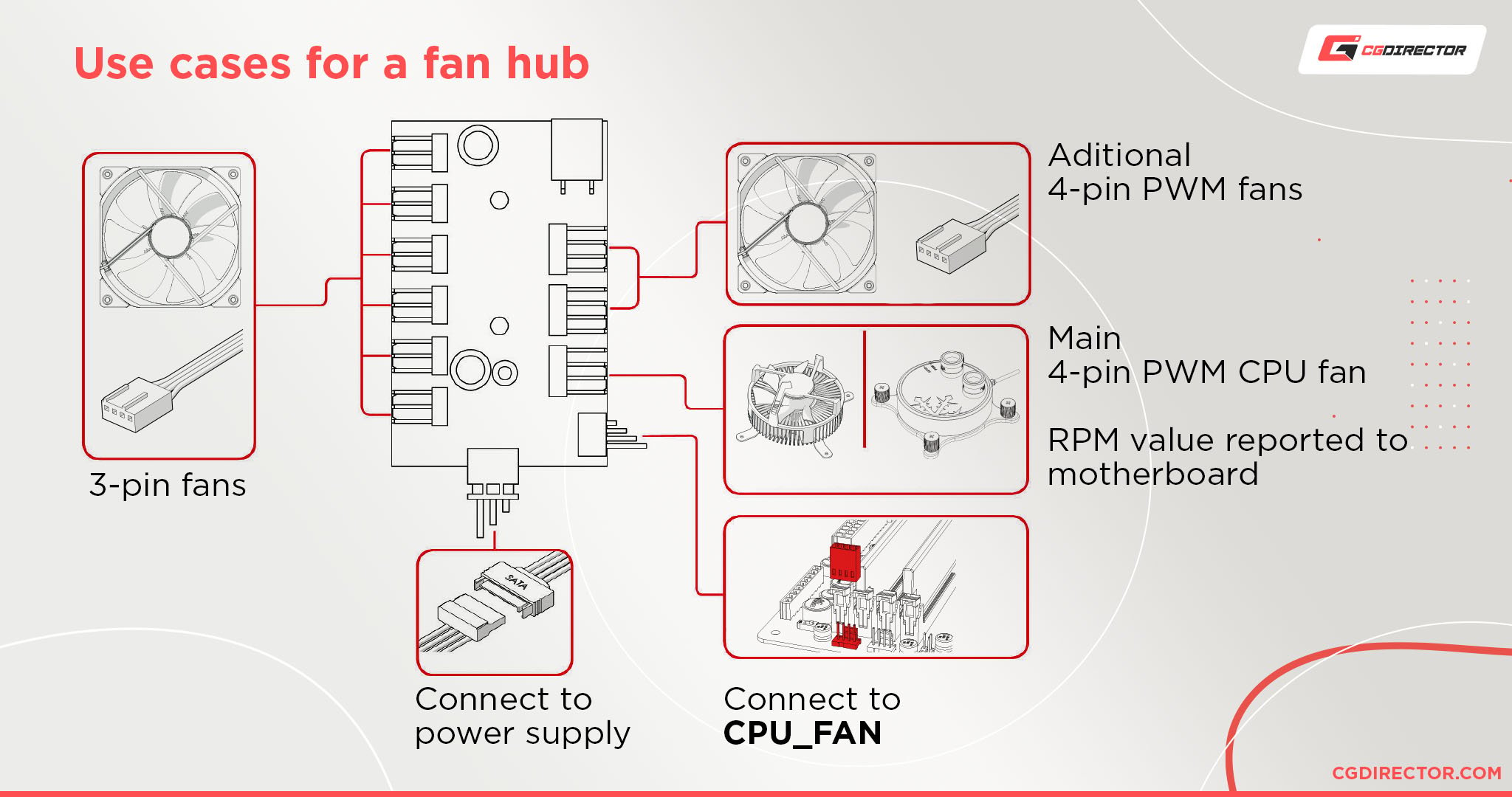
While older systems will crave fan controllers for even single-fan RGB setups, mod mid-range motherboards (similar AMD AM4 x570 Motherboards) tend to have at to the lowest degree one, sometimes two dedicated headers for RGB devices.
However, even if yous aren't using RGB…investing in a fan controller might exist necessary. This is especially common when building with Micro ATX or Mini ITX motherboards, which don't have very many connectors for fans.
In summation, buy a fan controller if any of the following points depict you:
- You desire to install more than instance fans than your motherboard will otherwise allow
- You desire to install an RGB fan, simply your motherboard does not support the feature
- You want to install more RGB case fans than your motherboard will otherwise allow
If you lot have no involvement in RGB and only want more fans in your arrangement, we recommend the SilverStone 8-Port PWM Fan Hub.
If your focus is on RGB, then you'll want to get with a controller matching the brand of any you pick. (ie if you choice Corsair, get their iCue Commander controller.) Until everyone agrees on a common standard for RGB lighting and control (please, guys), brand-matching fans and controllers is pretty much a necessity.
Who makes the all-time instance fans?
If y'all're looking for more general rather than specific recommendations, you may desire to know which brands to take a look at kickoff. There are plenty of great loftier-end instance fan manufacturers, but if we had to list the all-time case fan manufacturers:
- Noctua – For some of the best raw cooling potentials while keeping dissonance levels low.
- be Quiet! – Primarily for keeping noise levels low. Isn't always the absolute best in a given range, but generally stacks upwardly well at a good price.
- Corsair – Peachy static force per unit area RGB fans from Corsair.
- Thermaltake – Corking budget, niche, and sometimes budget RGB fans.
- Arctic – Arctic too makes some pretty expert budget case fans- with the exception that they are non PWM, so they are quite loud at all times.
Are expensive case fans worth information technology?
Depends on your use case.
If y'all want a very specific RGB fan setup with a liquid libation, opting for a great static pressure fan from Corsair makes a lot of sense. Meanwhile, if you want RGB but aren't liquid cooling, getting the cheaper Deepcool alternatives can let you prioritize airflow and value over aesthetics.
In full general, the most important things about a given example fan are:
- Do they support PWM to proceed noise levels low?
- Do they fit in your fan slot(due south) of choice?
- Practice they provide static pressure level for a cooler/narrow intake or loftier airflow for an exhaust/open up intake?
If you can answer yep to all of the to a higher place questions, that's a good fan- and it doesn't need to be expensive at all.
Best Case Fans – Our Picks
Now, it'due south fourth dimension to go over our height picks. We've selected Two Value picks commencement, with no existent extras but fairly superb airflow and decent static pressure for the toll. After that, we have a Quiet selection, an RGB Performance pick, and an incredibly powerful RGB Niche pick. Now, we'll provide detailed specs and discuss each of the products in particular:
Value Pick (No PWM) – Arctic F12 / All-time No PWM Case Fan
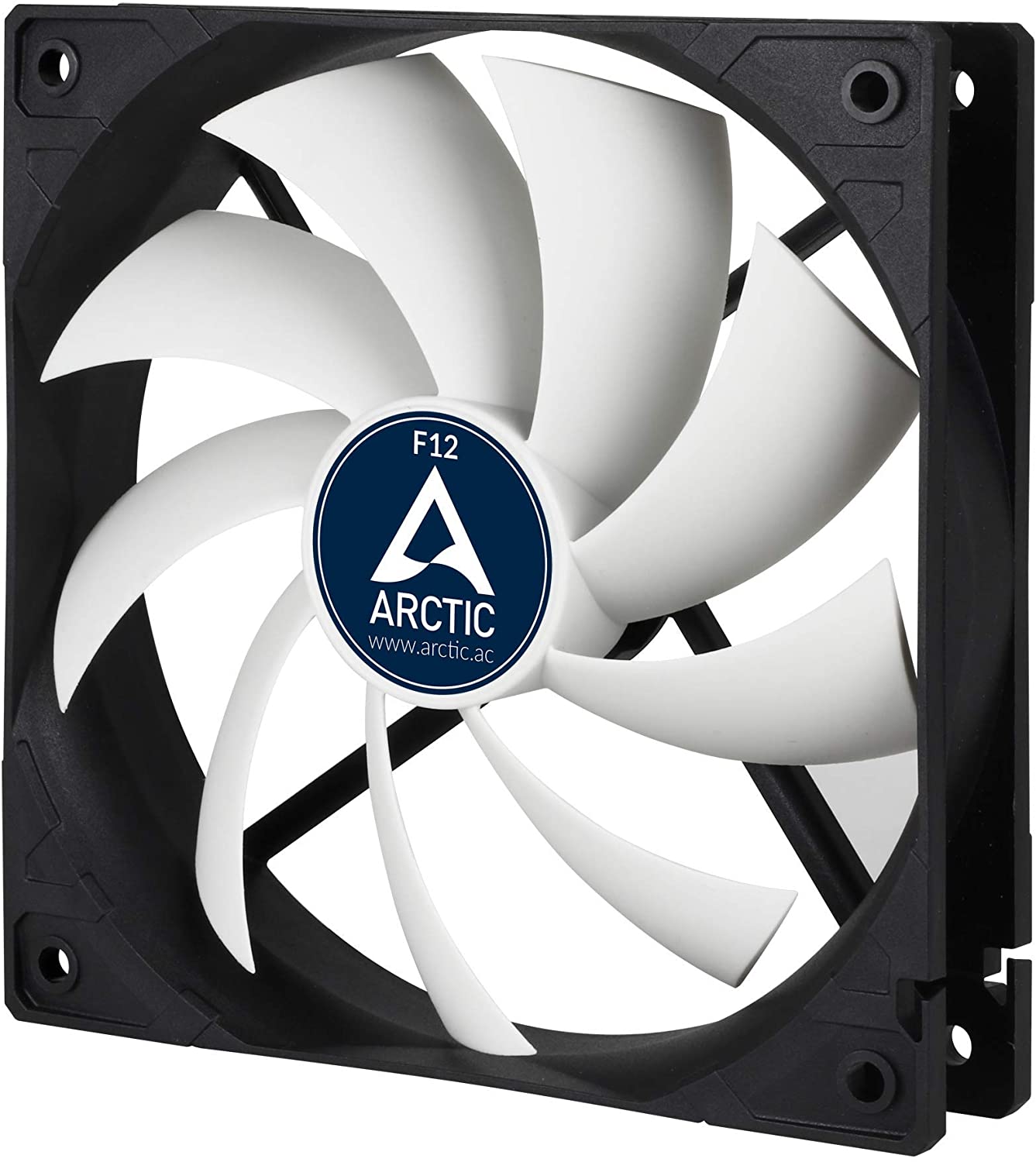
Epitome-Credit: Arctic
- Size – 120 mm
- Cubic Feet Per Infinitesimal (CFM) -53 CFM
- Max Rotations Per Minute (RPM) – 1350 RPM
- Pulse Width Modulation (PWM) Support – No
- Static Force per unit area or High Airflow? – Static Force per unit area
- Estimated Max Noise Level – 35 decibels
- RGB Support – No
If you're insistent on getting a case fan as inexpensive as possible and don't care about noise levels…hey, we get information technology. The author's done that exact thing before, even- with this exact fan!
The Chill F12 is a 120 mm cooling fan with the highest noise levels on this listing, no PWM to speak of, and honestly but okay raw CFM. Simply information technology'due south a static pressure level fan, so it'south actually pretty good at keeping a large heatsink or radiator absurd. If racket isn't a concern and all you need is raw performance. An Arctic F12 is a great selection!
Value Option – Noctua NF-P12 redux
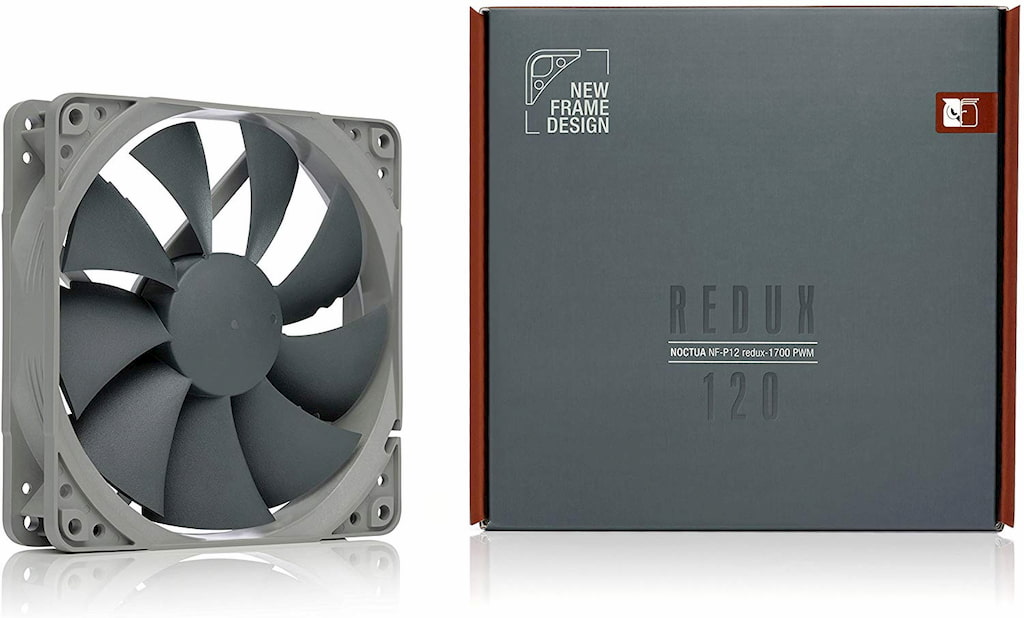
Prototype-Credit: Noctua
- Size – 120 mm
- Cubic Feet Per Minute (CFM) – 71 CFM
- Max Rotations Per Minute (RPM) – 1700 RPM
- Pulse Width Modulation (PWM) Back up – Yes
- Static Force per unit area or High Airflow? – Hybrid
- Estimated Max Dissonance Level – 25.i decibels
- RGB Support – No
Outset and foremost is our Value choice, which is a 120 mm fan with really adept airflow and…okay dissonance levels.
The Noctua NF-P12 redux is a fan with a dominantly-grey color that should alloy into the aesthetic of most cases, and boasts a truly impressive 71 CFM rating. It also provides decent static pressure, which ways that it should work well pretty much anywhere inside your PC: intake, exhaust, coolers, radiators…yous name it.
If all yous want is a cheap, no-fuss cooling solution for your PC, so this is information technology. It isn't particularly quiet, but it isn't specially loud, either. It boasts truly impressive raw airflow, it's cheap, and it comes from a reputable manufacturer- what more than could you want?
Quiet Pick – exist quiet! Silent Wings three Cooling Fan
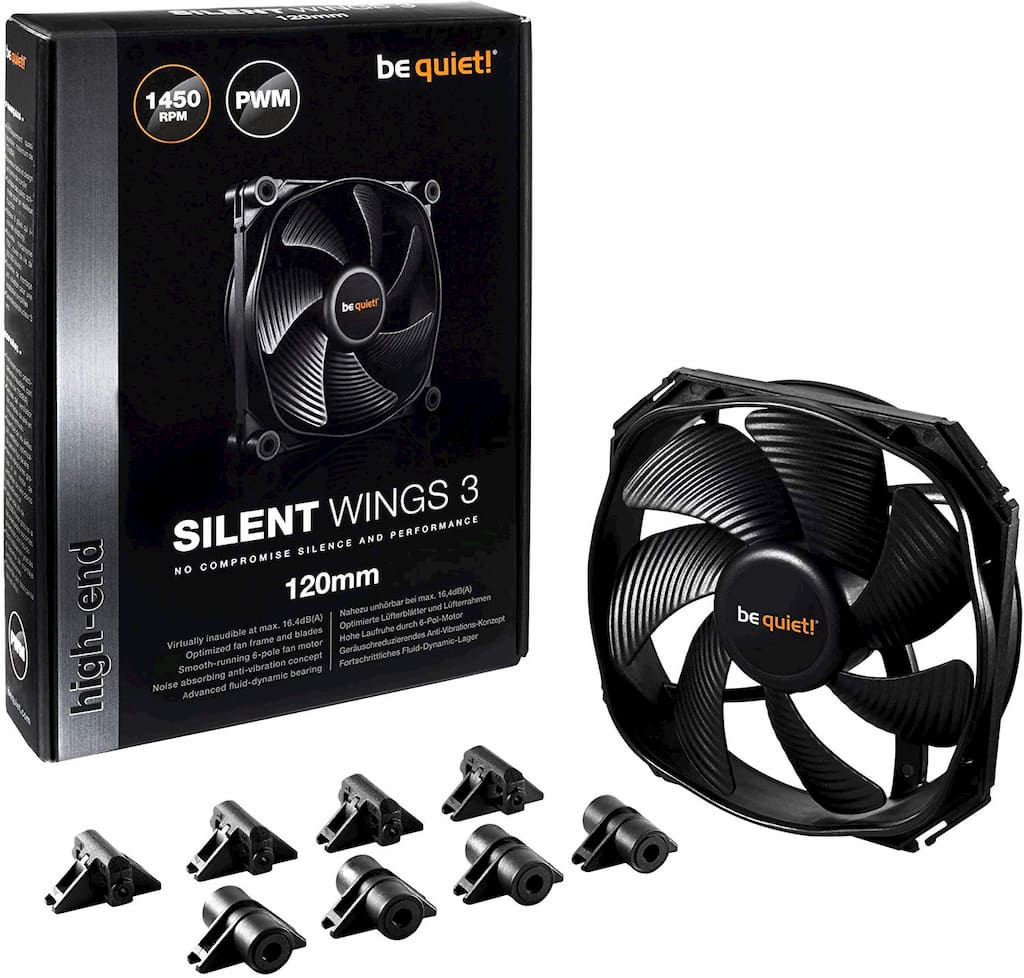
Image-Credit: beQuiet
- Size – 140 mm (120 bachelor)
- Cubic Feet Per Minute (CFM) – 59.5 CFM
- Max Rotations Per Minute (RPM) – grand RPM
- Pulse Width Modulation (PWM) Back up – Yep
- Static Pressure or High Airflow? – Static Pressure level
- Estimated Max Noise Level– 15.5 decibels
- RGB Back up – No
Our quiet pick comes from the aptly-named be quiet! Manufacturer. We've chosen their Silent Wings 3 Cooling Fan as our height pick- specifically the 140 mm model, though a 120 mm variant is available as well, should you want it.
The showtime thing you might notice is that, yes, this is the quietest fan on this listing. At a rating of 15.v decibels at even its maximum speed, this isn't a fan that's going to distract you with loud noises while you're chugging your PC through hardcore rendering or gaming tasks.
Nevertheless, the 2d thing y'all might observe is that its CFM is relatively low- simply nether sixty CFM, in fact. While this is certainly good, it too isn't groovy– why does it push less air than our budget pick?
For one, information technology's a static pressure fan. So while it pushes less air overall, it pushes air harder, which makes information technology specially ideal for intake from mostly-sealed front panels, or pushing cool air through a radiator/heatsink.
Simply besides…information technology's sort of an intrinsic downside of "tranquility" fans. For quiet fans, yous have to lower the maximum RPM and, with it, maximum airflow. This isn't specifically the quietest fan on the market, but it also pushes a lot more air than the quietest fans on the market.
We chose this one for the all-time compromise between raw performance and quiet operation.
RGB Performance Selection – Deepcool RF120 RGB Cooling Fan
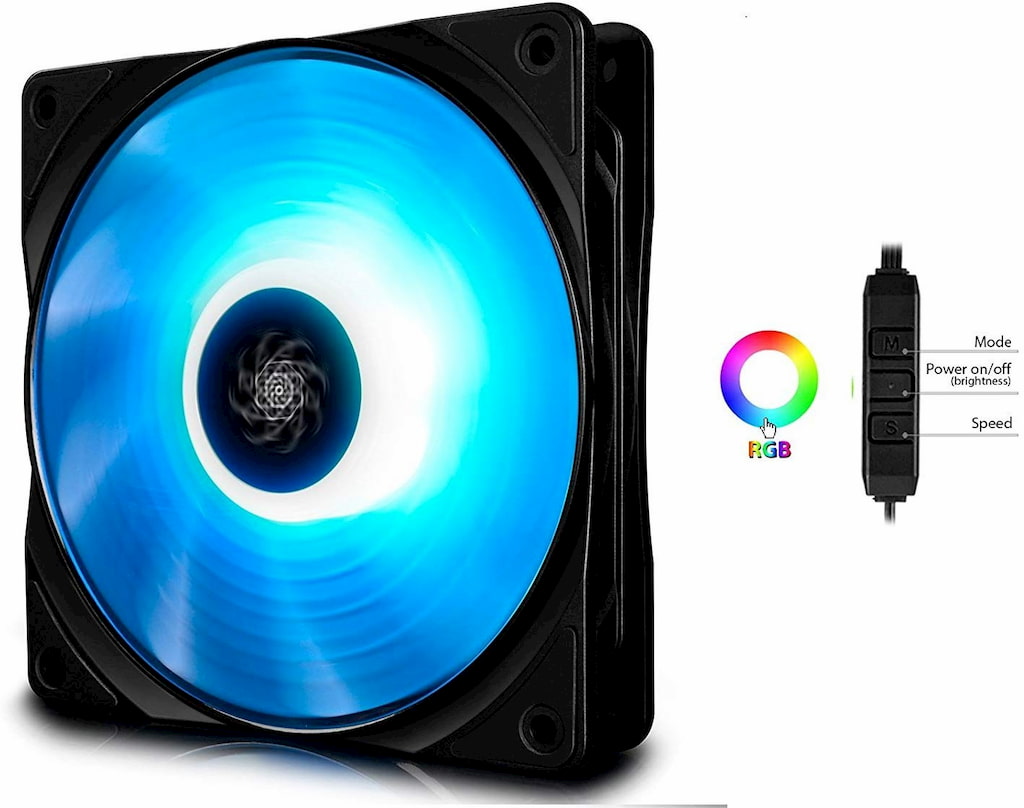
Image-Credit: Deepcool
- Size – 120 mm (140 available with alt. choice)
- Cubic Feet Per Infinitesimal (CFM) – 56.5 CFM
- Max Rotations Per Minute (RPM) – 1500 RPM
- Pulse Width Modulation (PWM) Support – Yes
- Static Pressure or High Airflow? – Loftier Airflow
- Estimated Max Noise Level– 25 decibels
- RGB Support – Yep
Now for our RGB pick!
Our main RGB choice doesn't come from any big names like Corsair or Thermaltake (not even so, anyhow). Instead, nosotros've selected the Deepcool RF120 RGB Cooling Fan. This is considering, even when compared to competing models from Corsair and other manufacturers, it has superb airflow…for an RGB fan.
RGB, like quietness, is another i of those things that don't direct impact fan functioning just are notwithstanding fairly important. Other manufacturers primarily provide static pressure RGB fans for this reason.
Static pressure level fans are great, don't go us wrong. However, if case cooling is your principal concern, and you aren't dealing with a sealed front end panel…then using a proper High Airflow fan for intake/exhaust is generally the all-time movement.
The Deepcool RF120 RGB Cooling Fan boasts compatibility with modernistic RGB headers on your motherboard and an included (albeit simplified) RGB controller. Since Airflow is the primary concern for most users, this is the decision nosotros've gone with.
Want a Static Pressure level alternative for radiators, coolers, or intake? Or just desire better RGB? Go the Corsair LL140 / LL120 instead
RGB Niche Pick – Thermaltake Riing Plus 20 RGB TT Premium
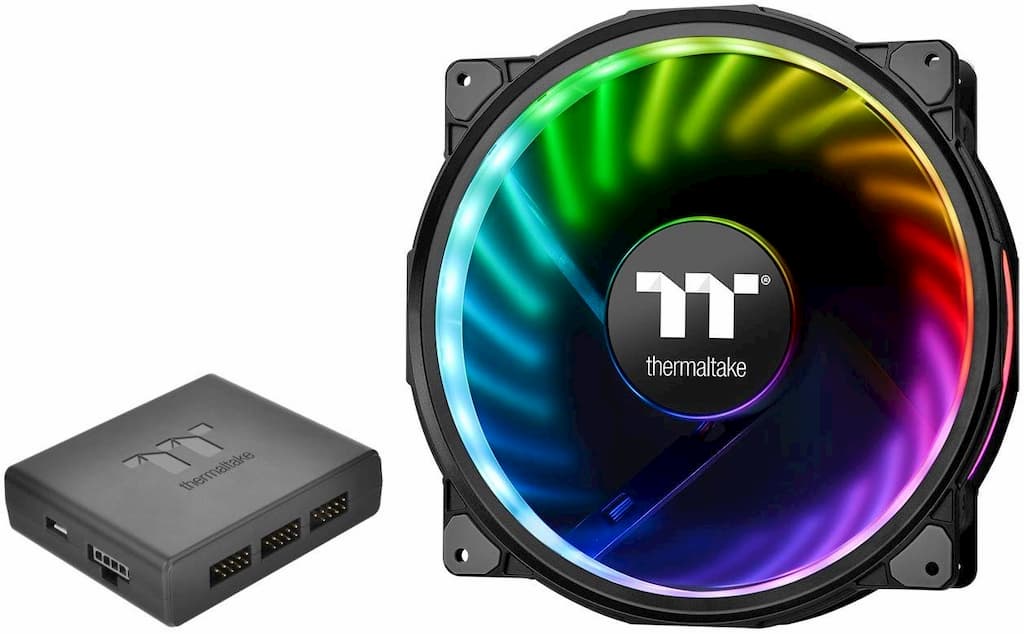
Image-Credit: Thermaltake
- Size – 200 mm
- Cubic Feet Per Infinitesimal (CFM) – 117.98 CFM
- Max Rotations Per Minute (RPM) – thou RPM
- Pulse Width Modulation (PWM) Support – Yes
- Static Pressure or Loftier Airflow? – Hybrid
- Estimated Max Noise Level – 29.2 decibels
- RGB Support – Yep
Last just not necessarily to the lowest degree is our RGB Niche pick, the Thermaltake Riing Plus 20 RGB Premium Edition.
This is a fauna of a 200 mm fan, boasting incredible RGB support, ultra-high airflow, and slap-up static pressure. It'due south perfect for pretty much any scenario…where you lot can really fit the behemoth inside. Micro ATX cube cases and certain full-sized ATX towers are most likely to fit a fan of this size.
If y'all're able to buy a case that can support a fan similar this, we highly recommend going for it. The sheer airflow you can become with even i of these fans is truly impressive, and nosotros've fifty-fifty seen some cases that tin can have 2. We don't think nosotros're exaggerating when we say this is the biggest, best RGB fan nosotros've ever seen– and a fan controller comes bundled with it!
FAQ
How do you measure out a PC'south Case Fan Size?
You measure the vertical or horizontal screw-pigsty distance – non diagonally! So the screw hole distance of a 120mm Case Fan would be 120mm.
How to add more Fans than a Motherboard supports?
If you want to add more Case Fans than your Motherboard has Fan headers, y'all can get a so-chosen "PC fan hub". Some models let you control upward to 12 additional Fans.
Over to you
That's nigh it! Need help choosing a Instance Fan or PC-Build? Let us know in the comments or ask our Forum experts 🙂
CGDirector is Reader-supported. When you purchase through our links, we may earn an affiliate committee.
What Size Case Fan Do I Need,
Source: https://www.cgdirector.com/best-case-fans/
Posted by: messerguill1987.blogspot.com


0 Response to "What Size Case Fan Do I Need"
Post a Comment